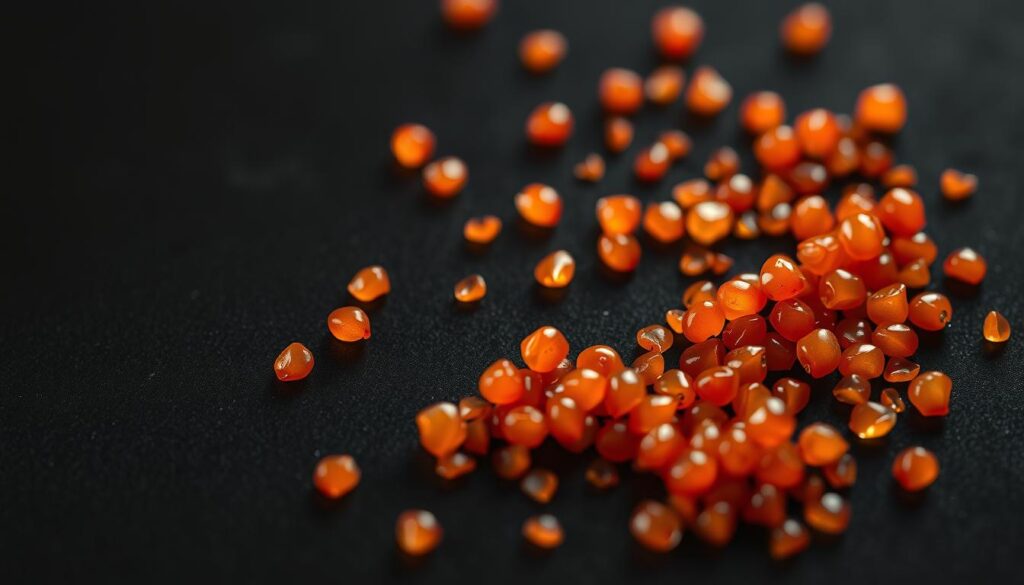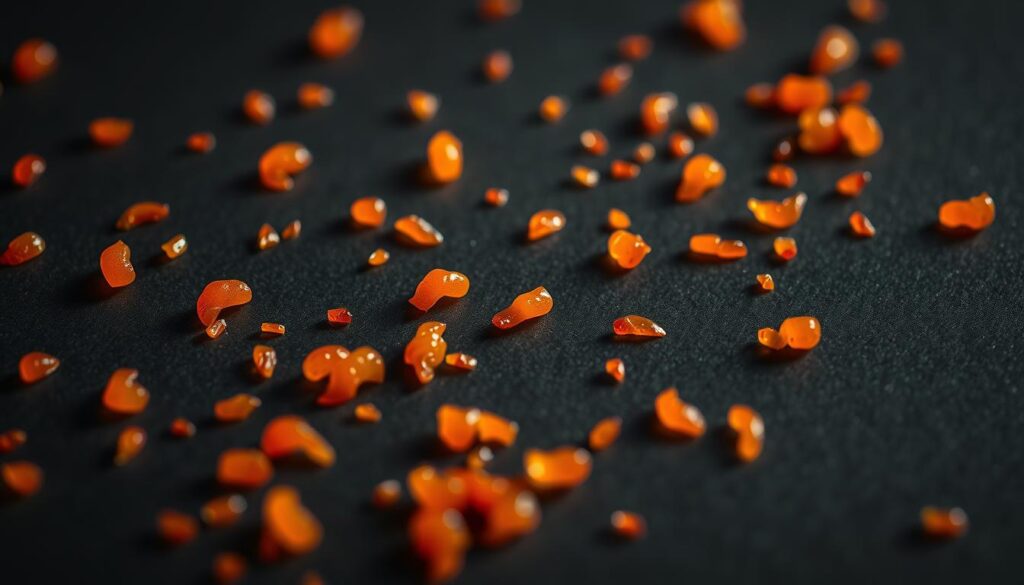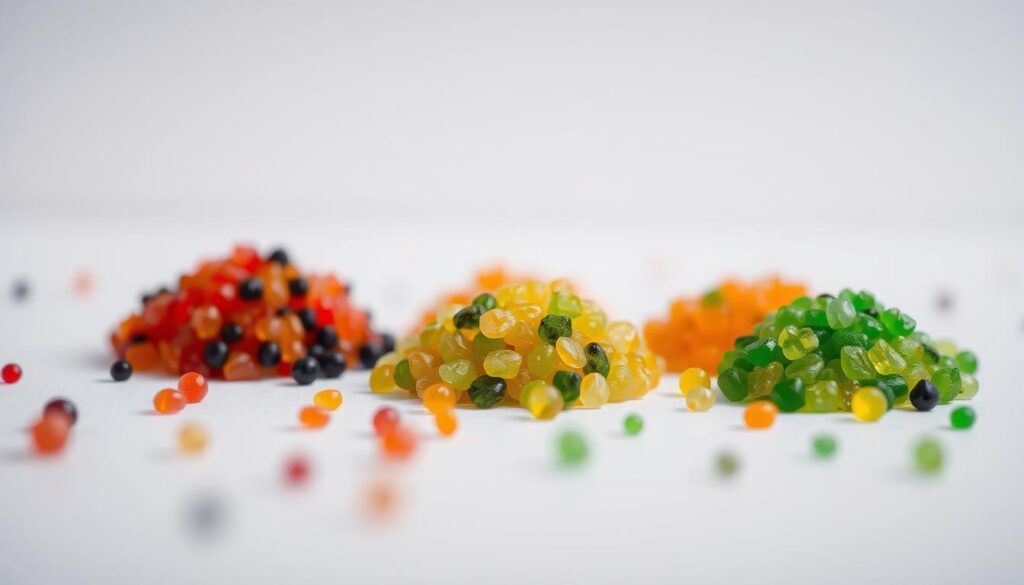Tobiko is a vibrant orange sushi topping known for its crunchy texture. It’s a key part of Japanese cuisine, adding flavor and color to sushi. Tobiko is a favorite in sushi restaurants across the United States.
Tobiko is a sought-after ingredient in sushi. Its unique taste and texture make it a hit. It adds flavor and color to sushi rolls, loved by sushi fans. Whether you like traditional or modern sushi, tobiko is essential.
Tobiko has a rich history in Japanese cuisine. It’s a big part of Japan’s culinary heritage. Now, it’s popular worldwide, with many restaurants adding it to their menus. We’ll explore tobiko’s origins, uses, and health benefits in this article.
Introduction to Tobiko
Key Takeaways
- Tobiko is a popular sushi topping made from flying fish roe
- It is known for its vibrant orange color and crunchy texture
- Tobiko is a key component in Japanese cuisine, adding flavor and visual appeal to sushi rolls
- It has a unique taste and texture, making it a staple in many sushi restaurants
- Tobiko is rich in nutrients and has various health benefits
- It can be used in various dishes beyond sushi, including seafood and fusion cuisine
What is Tobiko and Its Origins in Japanese Cuisine
Tobiko is a type of fish roe that has been a key part of Japanese food for centuries. It’s loved for its special taste and texture. This makes it a favorite in many Japanese dishes. The flying fish, found in Japan’s oceans, is where tobiko comes from.
In Japan, tobiko is seen as a luxury and often tops sushi and sashimi. Getting tobiko is hard work, which makes it rare and pricey. But, new tech and farming ways have made it easier to find and buy.

- It is rich in protein and low in calories
- It has a crunchy texture and a sweet, nutty flavor
- It is often used as a garnish for sushi and other Japanese dishes
Tobiko is not just a hit in Japan anymore. It’s becoming popular worldwide. Its unique taste and feel add something special to dishes like sushi, salads, and seafood. As more people want tobiko, we’ll see it more in restaurants and stores globally.
The Distinctive Characteristics of Tobiko
Tobiko is a vibrant orange seafood used in Japanese dishes. It has a crunchy texture and a sweet, salty flavor. This makes it a great choice for sushi topping and adding color to dishes.
Tobiko is also packed with protein and low in calories. It’s perfect for those who want to eat more seafood but are watching their diet. Its unique taste and texture let chefs get creative with sushi topping ideas.
Some of the key benefits of tobiko include:
- High protein content
- Low calorie count
- Rich in flavor and texture
- Versatile ingredient for sushi topping creations

Adding tobiko to your meals can introduce you to Japanese flavors and textures. It’s a great choice for both sushi fans and those new to it. Tobiko is a fantastic sushi topping to try.
Different Colors of Tobiko and Their Flavors
The vibrant roe of the flying fish is a key ingredient in Japanese cuisine, renowned for its wide range of colors and flavors. Each variety brings a unique taste, making it an excellent choice for seafood dishes. It’s especially beloved by chefs for its ability to add both flavor and color to sushi and sashimi.
This roe comes in several colors, such as orange, black, red, and green, with each hue derived from different ingredients. For example, black is often made with squid ink, while the red variety may offer a spicier kick. The different flavors, ranging from the mild sweetness of orange to the boldness of red, allow for a diverse and exciting culinary experience.
These vibrant roe varieties not only enhance the visual appeal of dishes but also provide a delightful burst of flavor that complements various ingredients, elevating your meal to a new level of deliciousness.
Natural Orange Tobiko
Natural orange tobiko is the most common type. It tastes sweet and slightly salty. It’s often used as a garnish or in sushi rolls for extra flavor and texture.
Flavored Tobiko Varieties
There are also black, red, and green tobiko varieties. Black tobiko tastes deeper and more savory because of squid ink. Red tobiko is spicy from chili peppers. Green tobiko, made with wasabi, has a pungent, sweet flavor. These flavors can add a unique twist to seafood dishes.

Adding tobiko to your dishes can make them better, especially with seafood. It’s great for adding color or flavor. Tobiko can improve both traditional Japanese dishes and modern seafood creations.
Nutritional Benefits of Tobiko
Tobiko is a seafood ingredient that’s packed with nutrients. It’s high in protein and low in calories, perfect for those who care about their health. It also has omega-3 fatty acids, which are good for the heart. These benefits make tobiko a favorite in seafood dishes, adding nutrition to every bite.
Here are some key benefits of tobiko:
- High protein content: Tobiko is a great source of protein, helping to build and repair muscles.
- Low calorie count: Its low calorie count makes it great for those watching their weight.
- Rich in omega-3 fatty acids: Tobiko is a good source of omega-3s, important for heart health and brain function.
- Low mercury levels: Unlike some seafood, tobiko has low mercury levels, making it safe to eat.
Overall, tobiko is a nutritious addition to seafood dishes. It boosts nutrition and health.
How Tobiko Differs from Other Fish Roe
Tobiko is a popular fish roe used in sushi and other seafood dishes. It has distinct characteristics that make it stand out. Unlike other roes like Masago and Ikura, tobiko has a unique flavor and texture.
When comparing seafood, tobiko is often mentioned alongside caviar, made from sturgeon roe. However, tobiko tastes more delicate and is less expensive than caviar. This makes it a great choice for adding luxury to dishes without breaking the bank.
Comparison with Other Fish Roe
- Masago: a type of capelin roe that is smaller and more delicate than tobiko
- Ikura: made from salmon roe, has a larger, more robust flavor than tobiko
- Caviar: made from sturgeon roe, is a more expensive and exclusive ingredient than tobiko
Using tobiko in seafood dishes requires balancing its delicate flavor with other ingredients. It’s perfect for sushi, sashimi, or seafood salads. Tobiko adds a burst of flavor and texture, making any dish more elegant. Its unique qualities make it a great choice for adding seafood elegance to your cooking.
Popular Sushi Rolls Featuring Tobiko
Tobiko is a favorite in many sushi rolls. It adds a burst of flavor and color. In Japanese In Japanese cuisine, the vibrant roe of the flying fish enhances both the appearance and taste of sushi rolls. Its bright colors and distinctive crunch make it a perfect addition to many sushi creations.
Some popular sushi rolls that feature this roe include:
- California roll: A classic roll filled with crab, cucumber, and roe, wrapped in rice and nori seaweed.
- Spider roll: A roll filled with soft-shell crab, cucumber, and roe, wrapped in rice and nori seaweed.
- Rainbow roll: A roll filled with crab, cucumber, and roe, topped with thinly sliced salmon, tuna, and white tuna.
These rolls not only taste delicious but also highlight the versatility of this roe in Japanese cuisine. It can be used in everything from traditional rolls to more inventive, modern creations.
Beyond sushi rolls, this roe is also a popular ingredient in other Japanese dishes like sashimi and nigiri. Its unique flavor and satisfying texture make it a favorite among sushi enthusiasts and chefs alike, adding an extra layer of flavor to various dishes.
Creative Ways to Use Tobiko Beyond Sushi
Tobiko is more than just for sushi. It brings a unique taste and texture to many dishes. It’s great in seafood and fusion foods.
As a Garnish
Use tobiko as a garnish to brighten up dishes. It’s perfect for seafood salads, pasta, and stir-fries. It also adds color to tacos and seafood burgers.
In Seafood Dishes
Tobiko adds flavor and texture to seafood soups, stews, and casseroles. It’s also good in seafood sauces and marinades.
Modern Fusion Applications
Try tobiko in modern dishes like seafood tacos, burgers, and sauces. It’s also great in salads and stir-fries.
Here are some fusion dishes with tobiko:
- Seafood tacos with tobiko and avocado
- Seafood burgers with tobiko and lettuce
- Seafood stir-fries with tobiko and vegetables
Storing and Handling Fresh Tobiko
Keeping tobiko fresh and safe is key. This delicate seafood needs careful storage to avoid spoilage. Store it in a cool, dry place, like a fridge, to keep it fresh.
When handling tobiko, use clean tools and surfaces. This helps prevent contamination, especially when it’s near other seafood. Proper handling and storage ensure you get the most from tobiko without risking foodborne illness.
Here are some tips for storing and handling tobiko:
- Keep tobiko refrigerated at a temperature below 40°F (4°C)
- Use airtight containers to prevent moisture and other contaminants from affecting the tobiko
- Consume tobiko within a few days of opening to ensure maximum freshness and quality
By following these tips, you can enjoy tobiko‘s unique taste and health benefits. Whether it’s as a sushi topping or in other seafood dishes, proper storage and handling are crucial for a great experience.
Where to Buy Quality Tobiko in the United States
In the United States, top-quality roe of the flying fish is available in Japanese markets, which specialize in providing authentic Japanese ingredients. These markets offer a wide variety of roe, including different colors and flavors, making it a great choice for seafood lovers.
When shopping for roe, it’s important to look for signs of quality. Fresh roe should have a vibrant orange color and a satisfying crunch. Also, check the packaging and labels to ensure the product is sustainably sourced. Many online stores also sell roe, offering a convenient way to purchase it without leaving your home.
Quality Indicators to Look For:
- Freshness: Fresh roe should have a bright orange color and a crunchy texture.
- Labeling: Ensure the packaging indicates that the roe is sustainably sourced and properly handled.
- Texture: The roe should have a firm, crisp texture when fresh.
Whether you’re shopping at Japanese markets or online, it’s important to prioritize quality and sustainability. This ensures that you can enjoy the unique taste and health benefits of roe while supporting eco-friendly fishing practices.
Common Misconceptions About Tobiko
Tobiko, a popular seafood ingredient, is often misunderstood. Many think it’s a type of caviar, but it’s not. It’s actually the roe of flying fish, with a unique flavor and texture.
Another common belief is that tobiko is only for sushi. But it’s also great in seafood salads and pasta dishes. Its versatility makes it a fantastic ingredient to have around.
- As a garnish for seafood dishes
- As an ingredient in seafood salads
- As a topping for sushi and sashimi
Some also think tobiko is expensive and exclusive. But, high-quality tobiko can be pricey, yet affordable options exist.
There are many misconceptions about tobiko. By understanding what it is and how to use it, seafood lovers can enjoy its unique flavor and versatility. Whether you’re a seasoned chef or new to seafood, tobiko is worth trying.
| Misconception | Reality |
|---|---|
| Tobiko is a type of caviar | Tobiko is the roe of flying fish |
| Tobiko is only used in sushi | Tobiko can be used in a variety of dishes |
| Tobiko is expensive and exclusive | Tobiko can be found at affordable prices |
Selecting and Pairing Tobiko in Your Dishes
When picking tobiko for your dishes, think about its taste and feel. Tobiko goes well with many things like seafood, veggies, and grains. You can sprinkle it on sushi, salads, or other foods. Or mix it into sauces and marinades for extra flavor and texture.
For great pairing, mix the tastes and textures right. For instance, tobiko‘s sweetness pairs well with seafood‘s savory taste. Its crunchy feel also matches soft veggies. Here are some tasty pairing ideas:
- Tobiko and salmon sashimi
- Tobiko and crab salad
- Tobiko and grilled shrimp
Choose tobiko that’s fresh and has a nice texture. You can find it at Japanese markets or online. With some creativity, tobiko can spice up many dishes, from sushi and seafood to salads and sauces.
Conclusion:
Tobiko is much more than just a garnish for sushi. It’s a versatile ingredient that can elevate the flavors and textures of various dishes across modern cuisine. With its bright, colorful appearance and unique crunch, this ingredient can be used in many unexpected ways. While it’s traditionally seen topping sushi rolls, its versatility extends to seafood dishes, salads, sauces, and even some desserts.
The four primary colors—orange, black, red, and green—offer different flavor profiles that can complement a variety of ingredients. Orange is the most common, with a delicate, slightly salty flavor, while black, often made from squid ink, has a richer, umami-filled taste. Red is typically used for its vibrant color and carries a slightly spicier edge, and green can have a subtle wasabi flavor, adding a bold kick to dishes. Each variety allows you to tailor the taste and look of your dish depending on the specific culinary needs.
Incorporating this roe into your cooking opens up a world of possibilities. It can add an exciting crunch to seafood pasta, enhance the flavor of fresh salads, or create an unexpected texture in creamy sauces. With a bit of creativity, you can incorporate this delicate, yet impactful ingredient into both savory and sweet dishes. To ensure the best results, it’s important to choose high-quality roe and handle it with care. This way, you can truly bring a unique Japanese touch to your cooking and create flavorful dishes that stand out.
FAQ
What is Tobiko and where does it come from?
Tobiko is fish roe from flying fish. It’s been in Japanese food for centuries. It’s prized for its unique taste and texture.
What are the distinctive characteristics of Tobiko?
Tobiko is bright orange and crunchy. It adds a sweet and salty flavor to dishes. This makes it a great addition to sushi.
What are the different colors of Tobiko and their flavors?
Tobiko comes in various colors, each with its own taste. Orange one is sweet and slightly salty. Black one has a deep, savory taste. Red one is spicy, and green one is pungent and sweet.
How does Tobiko differ from other types of fish roe?
Tobiko is different from Masago, Ikura, and caviar. Masago is smaller and more delicate. Ikura has a bigger flavor. Caviar is more expensive and exclusive.
What are some popular sushi rolls that feature Tobiko?
Tobiko is in popular sushi rolls like the California roll and the rainbow roll. It adds flavor and color, making these rolls more appealing.
Can Tobiko be used in dishes beyond sushi?
Yes, Tobiko is great in many dishes. It’s good as a garnish or in seafood dishes. It’s also used in modern dishes like tacos and seafood burgers.
How should Tobiko be stored and handled?
Fresh Tobiko needs cool, dry storage. Keep it in the fridge and use it within a few days. Always use clean utensils to avoid contamination.
Where can I buy quality Tobiko in the United States?
You can find quality Tobiko in Japanese markets, online, and some seafood stores. Look for freshness, color, and texture when buying.
for more recipes , please click on link below:

